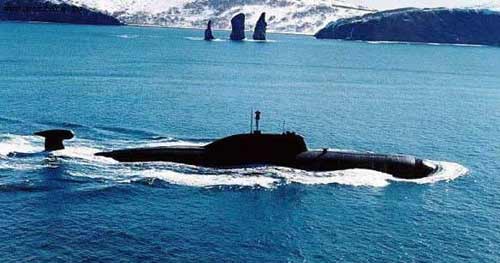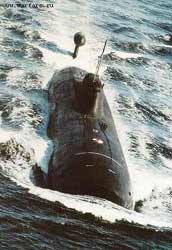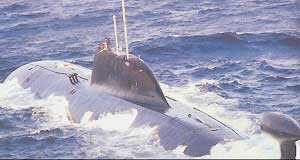Another setback for Indian Navy as accident on new Russian n-sub kills 20
10 Nov 2008
Moscow: Russian media on Sunday reported a serious accident onboard its latest Schucka-B (Pike class/NATO code: Akula 2) nuclear powered hunter killer attack submarine, the Nerpa. Reports suggested that a fire extinguishing system in the forward compartment of the submarine was accidentally activated, which released Freon gas into two compartments killing 20 people and hospitalising 21 others.
The new Akula 2 submarine was undergoing trials in the Sea of Japan.

The Russian Navy stressed the submarine itself was unaffected and had returned to its base on Russia's Pacific coast under its own power. Navy spokesman Capt Igor Dygalo said the accident also did not pose any radiation danger. "The submarine's nuclear reactor was operating normally and radiation levels were normal," Dygalo said.
Though both Russia and India have studiously refrained from confirming a likely lease deal, it is widely speculated that the Nerpa was due to be leased to the Indian Navy (IN) and was due for induction next year on the occasion of India's Independence Day celebrations on 15 August. It is also widely held that the semi-finished Nerpa was constructed with Indian funding.
Though IN personnel have been in Russia for a considerable period of time undergoing training for the handling of nuclear submarines, particularly of the sophistication of the Schucka-B class, no Indian personnel were on board the vessel at the time of the accident. The Nerpa is primarily meant to train IN crew in the handling of nuclear subs and is likely to play a key role in the training of its personnel, even as the first of its own nuclear subs is readied for sea trials sometime next year.
The IN is slated to roll out three indigenously designed and constructed submarines. The Nerpa is meant to be inducted into the IN as the INS Chakra.
Meanwhile, it was reported that a contingent of 40 Indian Navy personnel was due to board the Nerpa shortly in order to take part in the sea trials currently underway off the Russian base of Vladivostok.
As for the accident, Capt Dyagalo said it had affected two sections of the submarine ''closest to the bow.'' This may be taken as a euphemistic reference to the torpedo section of the submarine.
Incidentally, it was an exploding torpedo that had sunk the massive Russian Navy Oscar-II Class nuclear-powered cruise missile submarine, the Kursk, in August 2000. Although the exact causes of the accident, which killed 116 crew and 2 designers, remains shrouded in secrecy and mystery, it is widely held that it was the explosion of a newly designed torpedo that had sunk the massive 24,000 tonne (submerged) submarine.
 As for the Nerpa, Russian investigating officials are being quoted as saying that the victims suffocated after the submarine's fire-extinguishing system released Freon gas, which apparently has been found in their lungs after forensic examination. Of the 20 dead, 17 were civilians and three seamen.
As for the Nerpa, Russian investigating officials are being quoted as saying that the victims suffocated after the submarine's fire-extinguishing system released Freon gas, which apparently has been found in their lungs after forensic examination. Of the 20 dead, 17 were civilians and three seamen.
Capt Dygalo said that none of the injuries of 21 others hospitalized was life-threatening.
Observers are assigning one of the reasons for the high casualty rate to overcrowding. The Schucka-B (Akula 2) class submarine has a crew strength of 73, but reports suggest that the submarine may have been carrying as many as 208 people on board, including 81 seamen. Experienced submariners say that a submarine is at its most vulnerable during trials as it is difficult to keep movement and action organized with both Navy and civilian personnel onboard.
Another puzzling factor for observers is the fact that the fatalities apparently got no time to put on their individual breathing kits which all personnel on board are supposed to carry with them. Ex-Russian submariners are pointing out that it is likely that the civilian personnel onboard may not have had any experience in operating these breathing systems.
 More ominously, it is being surmised that the submarine may not have been carrying enough breathing kits to serve people who numbered three times more than its normal complement.
More ominously, it is being surmised that the submarine may not have been carrying enough breathing kits to serve people who numbered three times more than its normal complement.
It is also likely that an alarm system warning the crew that the firefighting system had turned on may have failed. Those on board may not have realized that Freon was being released until it was too late.
The submarine returned Sunday to Bolshoi Kamen, a military shipyard and a navy base near Vladivostok. According to Dygalo, the Nerpa was to be commissioned by the navy later this year.
The Nerpa is the 11th ship of the Schucka/Akula class, though one of the very few of the Schucka-B/Akula 2 class.







.webp)














